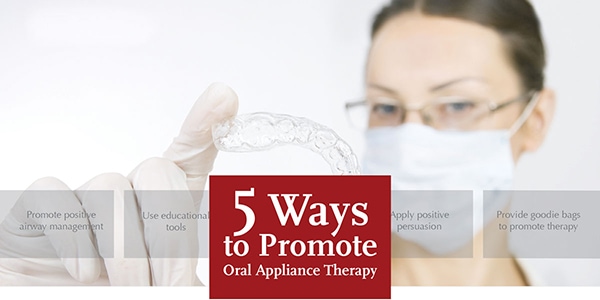In this issue of DSP we dive into oral appliances and look at different aspects of the actual devices. These powerful little custom-made mouthpieces are created to reduce the amount of collapsibility of the airway during sleep, a service that clinical research is showing to be more and more important. Here are five ways to promote oral appliance therapy with the help of positive persuasion.

1. Promote positive airway management
When patients have an issue breathing during sleep it’s best to promote positive airway management. Some patients we talk to will need a sleep study and others will have a previous diagnosis of OSA. Both types of patients will need positive reinforcement to act on complying with getting a test or doing therapy. Any therapy. This could be PAP therapy, surgery, lifestyle changes, and oral appliance therapy. It’s best to keep your focus on the main goal, which is to help patients breathe better during sleep no matter which way they choose to do it.
2. Use educational tools
Create, purchase or borrow pictures, diagrams and videos to illustrate to patients what happens with airway anatomy during sleep. Visual aids are a great way to communicate with patients. Some patients just need a little explanation to fully understand obstructed breathing during sleep. Great Lakes Orthodontics lab has some great educational tools such as the OSA Demonstrator. Visit http://www.greatlakesortho.com/commerce/detail/?nPID=1920&returnTo=http://www.greatlakesortho.com/commerce/category/index.cfm?cid=138&lvl=2 to check it out. You can also download and print color diagrams (see image below) for your treatment rooms from my website www.dsmbootcamp.com. This is my gift to you for reading the team column! My suggestion is to laminate them so you can wipe them down between patients.
3. Apply positive persuasion
Based off a recent study published by the National Center for Biotechnology Information. Ref: http://www.ncbi.nlm.nih.gov/pubmed/24417326 The study explains that with some patients when they think they had a good night’s sleep it can improve cognitive function! Let your patients know you are excited to see their sleep improve and see symptoms get better. It’s never a good idea to promise any therapy is going to work 100% or guarantee success as bodies respond differently. However, we can promote how excited we are about therapy outcomes and patient success. Talk about how other patients were nervous to start therapy but after they got used to it, the success was tremendous. Never share patient names or personal information but keep track of patient success. A simple spreadsheet of before and after symptoms, AHI/RDI/O2 outcomes or Epworth scores will be beneficial. Patients look to the team for answers; they pick up on our body language, tone and inflection in our voice. Let’s promote how great our therapy works!
4. Provide goodie bags to promote therapy
Who doesn’t love an gift? Your patients will love something to take home when they are first being introduced to sleep like a brochure, newsletter, or app. Dr. Kent Smith, a dental sleep medicine dentist and instructor in Irving TX, has a great free app about sleep hygiene. It’s called Best Sleep Hygiene. Once your patients start oral appliance therapy give them a goodie bag to reinforce good sleep hygiene. Include things like Chamomile tea, eye masks, ear plugs, nose cones or strips, white noise apps, sleep tracker app, sleep diary, coffee mug and a denture brush to clean the appliance. You can get creative with this. Make it game to see who can come up with the best goodies for the least amount of cost.
5. Supply patient surveys
According to Forbes magazine it’s best customer service when you are surveying your clients – in our case our patients. Once patients are stable with their therapy ask them to rate their experience with you. If they are rating you top notch you can use that for marketing and promotional purposes, and even better, if they don’t give you a high rating it’s a great opportunity to find out why and improve your processes.
As we focus on oral appliances in this issue as a team we need to focus on the overall positive effects of oral appliance therapy and promote it to our patients. Always remember our therapy is reversible, non-surgical and non-pharmaceutical. However, it can be used in conjunction with surgery or medication if needed. We have a solid dental solution to a medical issue, it’s time we promote this to all patients and promote our positive patient outcomes!
This Sleep Team Column will be dedicated to the team and provide practical tips and resourceful information. Let us know your specific issues by email to: editor@DentalSleepPractice.com, while we can’t respond to every individual. Your feedback will help us create the most useful Sleep Team Column we can!

